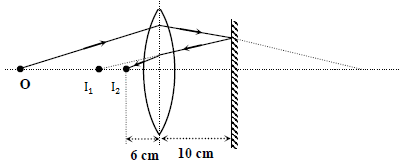
Answer
463.5k+ views
Hint:Biconvex lens are simple lenses which consist of two convex surfaces in spherical form, generally having the same kind of curvature.
Complete step by step answer:
We get the image distance by using lens
Formula \[\dfrac{1}{v}-\dfrac{1}{u}=\dfrac{1}{f}\Rightarrow \dfrac{1}{v}=\dfrac{1}{15}-\dfrac{1}{30}\Rightarrow v=30\text{ cm}\]
\[v=30\text{ cm}\] in front of the Convex mirror, which means 20 cm behind the mirror. Assuming a mirror to reflect from both the sides, this image will act as a virtual object for the mirror and second image. \[{{I}_{2}}\] will be formed at 20 cm in front of the mirror.
1. Understanding the convention used while taking
\[+ve\] and \[-ve\]sign for Image and object distance, the direction along which ray of light is travel taken as \[+ve\]
2. Focal length:
For convex lens \[+ve\]
For concave lens \[-ve\]

So, here the ray of light is coming from behind the mirror towards lens, for the second image \[{{I}_{2}}\] with respect to lens,
\[u=+10\text{ cm};f=15\text{ cm}\]
By using lens formula
\[\dfrac{1}{v}-\dfrac{1}{u}=\dfrac{1}{f}\]
\[\Rightarrow \dfrac{1}{v}-\dfrac{1}{10}=\dfrac{1}{15}\]
\[\Rightarrow v=6\text{ cm}\]
So, this image is at a distance of \[10+6=16\text{ cm}\] in front of the mirror.
So, the correct answer is “Option B”.
Note:
In this we need to remember that we need to find the distance of the image from the mirror. So we need to add 10 to give a final answer.
Also real images are always inverted in nature. In this converging rays actually made a collection of focus points which we called a real image because generally an image is a collection of focus points in optics.
Complete step by step answer:
We get the image distance by using lens
Formula \[\dfrac{1}{v}-\dfrac{1}{u}=\dfrac{1}{f}\Rightarrow \dfrac{1}{v}=\dfrac{1}{15}-\dfrac{1}{30}\Rightarrow v=30\text{ cm}\]
\[v=30\text{ cm}\] in front of the Convex mirror, which means 20 cm behind the mirror. Assuming a mirror to reflect from both the sides, this image will act as a virtual object for the mirror and second image. \[{{I}_{2}}\] will be formed at 20 cm in front of the mirror.
1. Understanding the convention used while taking
\[+ve\] and \[-ve\]sign for Image and object distance, the direction along which ray of light is travel taken as \[+ve\]
2. Focal length:
For convex lens \[+ve\]
For concave lens \[-ve\]

So, here the ray of light is coming from behind the mirror towards lens, for the second image \[{{I}_{2}}\] with respect to lens,
\[u=+10\text{ cm};f=15\text{ cm}\]
By using lens formula
\[\dfrac{1}{v}-\dfrac{1}{u}=\dfrac{1}{f}\]
\[\Rightarrow \dfrac{1}{v}-\dfrac{1}{10}=\dfrac{1}{15}\]
\[\Rightarrow v=6\text{ cm}\]
So, this image is at a distance of \[10+6=16\text{ cm}\] in front of the mirror.
So, the correct answer is “Option B”.
Note:
In this we need to remember that we need to find the distance of the image from the mirror. So we need to add 10 to give a final answer.
Also real images are always inverted in nature. In this converging rays actually made a collection of focus points which we called a real image because generally an image is a collection of focus points in optics.
Recently Updated Pages
Who among the following was the religious guru of class 7 social science CBSE

what is the correct chronological order of the following class 10 social science CBSE

Which of the following was not the actual cause for class 10 social science CBSE

Which of the following statements is not correct A class 10 social science CBSE

Which of the following leaders was not present in the class 10 social science CBSE

Garampani Sanctuary is located at A Diphu Assam B Gangtok class 10 social science CBSE

Trending doubts
A rainbow has circular shape because A The earth is class 11 physics CBSE

Which are the Top 10 Largest Countries of the World?

Fill the blanks with the suitable prepositions 1 The class 9 english CBSE

How do you graph the function fx 4x class 9 maths CBSE

The Equation xxx + 2 is Satisfied when x is Equal to Class 10 Maths

What is BLO What is the full form of BLO class 8 social science CBSE

Give 10 examples for herbs , shrubs , climbers , creepers

What organs are located on the left side of your body class 11 biology CBSE

Change the following sentences into negative and interrogative class 10 english CBSE




